Nestled between the dappled sunlight of the woods and the open expanse of a garden lies the sunny edge of woods, a unique and often overlooked area brimming with potential for beautiful landscaping. In this article, we will delve into gardening ideas for sunny edges of woods, offering tips on how to harness the natural beauty of this transitional space.
The sunny edge of woods presents a blend of sunlight and shade, creating a microclimate that can challenge even seasoned gardeners. Understanding the soil composition, light conditions, and shade patterns specific to this area is crucial in selecting the right plants that thrive in these conditions. By carefully choosing flowering shrubs and perennials suited for this environment, you can create a vibrant and sustainable woodland edge garden.
Designing a layout that seamlessly transitions from the woods to your garden is key to enhancing the overall appeal of your outdoor space. By incorporating native plants that not only complement the existing ecosystem but also attract wildlife, you can boost biodiversity while promoting ecosystem health. Maintaining your woodland edge garden through proper pruning, watering, and weed control practices is essential in ensuring its long-term beauty and vitality.
Understanding the Unique Growing Conditions
The sunny edge of woods presents a unique set of growing conditions that are different from traditional garden settings. Understanding these conditions is essential for successfully cultivating a thriving garden in this environment.
One key factor to consider is the soil composition, which may vary significantly from the open garden areas due to being enriched with organic matter from decaying leaves and branches. This nutrient-rich soil can support a wide range of plants that are well-suited to woodland edges.
In addition to the soil, light and shade patterns play a crucial role in determining which plants will thrive in the sunny edge of woods. While this area receives ample sunlight, there may still be pockets of shade created by overhanging trees or shrubs.
It is important to take note of these microclimates when selecting plants for your garden to ensure they receive the appropriate amount of sunlight throughout the day. By carefully assessing the light and shade patterns, you can create a diverse and visually appealing garden that takes advantage of both sunny and shaded areas.
When choosing plants for the sunny edge of woods, opt for species that are adapted to partial shade conditions. Flowering shrubs and perennials like rhododendrons, azaleas, and ferns are excellent choices for adding color and texture to your woodland edge garden.
These plants not only tolerate dappled sunlight but also complement the natural beauty of the surrounding wooded area. By selecting the right plants based on soil composition, light availability, and shade patterns, you can create a harmonious garden that thrives in the unique growing conditions of the sunny edge of woods.
| Garden Plants | Suitable Light Conditions |
|---|---|
| Rhododendrons | Partial Shade |
| Azaleas | Dappled Sunlight |
| Ferns | Partial Shade |
Selecting the Right Plants for the Sunny Edge of Woods
When it comes to selecting the right plants for the sunny edge of woods, there are a few key factors to consider to ensure their success in this unique growing environment. The soil composition, amount of sunlight, and shade patterns play crucial roles in determining which plants will thrive in this transitional area between woodlands and open spaces. One important consideration is choosing plants that can tolerate dappled light as well as periods of direct sunlight throughout the day.
When deciding on flowering shrubs and perennials for your woodland edge garden, opt for species that are native to your region. Native plants have adapted to the local conditions over time and are more likely to flourish with minimal maintenance. Some popular choices include flowering dogwood, Virginia bluebells, black-eyed susans, and wild columbine. These plants not only add color and beauty to the sunny edge of woods but also support local wildlife by providing food and habitat.
To create a harmonious blend of vegetation at the edge of your woods, consider planting a mix of evergreen and deciduous shrubs interspersed with perennial flowers. This combination can provide year-round interest while supporting a diverse array of pollinators and beneficial insects.
Additionally, incorporating plants with varying heights and textures can add depth and visual appeal to your woodland edge garden. Experimenting with different plant combinations is a great way to discover what works best in your specific sunny woodland setting.
| Key Plants for Sunny Edge Gardens | Benefits |
|---|---|
| Flowering Dogwood | Attracts birds and butterflies; beautiful spring blossoms |
| Virginia Bluebells | Early spring flowers; shade-tolerant; attracts bees |
| Black-eyed Susans | Tolerates dry soil; attracts pollinators; adds vibrant color |
Designing a Layout
To create a natural transition, consider using materials such as mulch or natural stones for paths and borders. This will help blend the garden seamlessly with the surrounding wooded area. Additionally, incorporate elements such as wooden benches or rustic bird feeders that complement the natural setting and provide resting spots for both you and visiting wildlife.
When designing the layout, take into account existing trees, shrubs, and other features in the wooded area. Consider planting flowering shrubs and perennials along the edge of the woods to create a soft border between the two spaces. Group plants together in clusters or drifts to mimic how plants naturally grow in woodlands. This not only creates a harmonious design but also helps attract pollinators and wildlife to your sunny edge garden.
Incorporating raised beds or containers can also be an effective way to add color and interest to your woodland edge garden. Opt for planters made from natural materials like cedar or stone that will complement the surroundings. Mix in herbs, annuals, or vegetables for added visual appeal and functionality. By carefully planning and designing your layout, you can create a beautiful and inviting sunny edge of woods garden that seamlessly blends with nature while showcasing your gardening creativity.
Incorporating Native Plants
When gardening at the sunny edge of woods, incorporating native plants can significantly enhance biodiversity and promote ecosystem health. Native plants are adapted to the specific growing conditions of the area, making them low-maintenance and resilient choices for your garden. By utilizing native species, you can attract local wildlife, support pollinators, and create a more sustainable ecosystem overall.
Here are some examples of native plants that thrive at the sunny edge of woods:
- Oakleaf hydrangea (Hydrangea quercifolia): This beautiful shrub produces large panicles of white flowers in summer and has stunning fall foliage.
- Columbine (Aquilegia Canadensis): Known for its delicate red and yellow flowers, columbine is a favorite of hummingbirds and butterflies.
- Goldenrod (Solidago spp.): A late-season bloomer, goldenrod provides nectar for bees and butterflies while adding a pop of yellow to your garden.
Incorporating these native plants not only adds visual interest to your woodland edge garden but also plays a crucial role in supporting local ecosystems. By choosing plants that are well-suited to the environment, you can create a harmonious balance between your garden and the surrounding wooded area. Consider researching local native plant species or consulting with a garden center specializing in native plants for more options tailored to your specific location.
Maintaining Your Woodland Edge Garden
Maintaining a woodland edge garden requires attention to detail and regular upkeep to ensure the health and beauty of your plants. Proper pruning, watering, and weed control are essential tasks that will help your garden thrive in the unique conditions of the sunny edge of woods.
When it comes to pruning your plants at the sunny edge of woods, it’s important to understand each species’ specific needs. Some flowering shrubs may benefit from annual pruning after they have finished blooming, while others may require more frequent shaping throughout the growing season. Make sure to use sharp, clean tools to prevent disease transmission and always follow proper pruning techniques to promote healthy growth.
Proper watering is crucial for the success of your woodland edge garden, especially during hot summer months. Depending on the rainfall in your area and the moisture retention of your soil, you may need to supplement with additional water. Be sure to water deeply and infrequently to encourage deep root growth and reduce water waste. Consider using a soaker hose or drip irrigation system to deliver water directly to the plant roots without wetting the foliage unnecessarily.
- Regularly monitor soil moisture levels
- Water deeply and infrequently
- Avoid overhead watering whenever possible
Weed control is another important aspect of maintaining a healthy woodland edge garden. Weeds can compete with your plants for nutrients, water, and sunlight, so it’s essential to stay on top of them before they become a problem. Consider mulching around your plants to suppress weed growth and retain soil moisture. Hand pulling weeds or using organic weed control methods can also help keep your garden looking its best without harming beneficial insects or wildlife.
- Mulch around plants to suppress weeds
- Hand pull weeds regularly
- Use organic weed control methods when necessary
Attracting Wildlife
Creating Bird-Friendly Spaces
One of the best ways to enhance the biodiversity of your sunny edge garden is by attracting birds. Setting up birdhouses and feeders can provide shelter, food, and nesting sites for a variety of bird species. Choose birdhouses with different entrance hole sizes to accommodate various types of birds. Additionally, consider adding a birdbath or small water feature to attract more feathered visitors to your garden.
Building a Pollinator Paradise
Pollinators such as bees, butterflies, and hummingbirds play a crucial role in plant reproduction and ecosystem health. By planting pollinator-friendly flowers and creating a dedicated pollinator garden within your sunny edge space, you can support these important wildlife species. Choose flowers that bloom at different times throughout the year to provide nectar sources for pollinators from spring to fall. Include a mix of native plants and cultivars to attract a diverse range of pollinators.
Cultivating a Wildlife-Friendly Habitat
In addition to birdhouses, feeders, and pollinator gardens, there are other ways to create a wildlife-friendly habitat in your sunny edge garden. Consider leaving some brush piles or fallen logs as shelter for small mammals, reptiles, and amphibians.
Avoid using pesticides or herbicides that can harm wildlife populations and opt for natural pest control methods instead. By providing food, water, shelter, and minimizing human disturbances in your garden, you can create a thriving ecosystem that benefits both wildlife and plants in the sunny edge of woods.
Seasonal Interest
When creating a garden at the sunny edge of woods, one important aspect to consider is how to maintain its beauty year-round. By carefully selecting plants that offer interest in different seasons, you can ensure that your woodland edge garden remains visually appealing no matter the time of year.
Choosing Plants for Year-Round Interest
To keep your sunny edge garden looking beautiful throughout the seasons, it is essential to select a mix of plants that provide interest in different ways. Consider incorporating a variety of flowering shrubs and perennials that bloom at different times of the year, ensuring that there is always something in bloom. Additionally, include plants with attractive foliage or interesting textures that will add visual appeal even when not in flower.
Adding Elements for Winter Interest
During the winter months when many plants are dormant, it’s important to incorporate elements that provide interest and structure to your garden. Consider planting evergreen shrubs or trees that will provide color and texture even in the colder months. You can also include ornamental grasses or plants with interesting seed heads that add visual appeal during the winter.
Maintaining Seasonal Variations
As the seasons change, it’s essential to adjust your maintenance routine to ensure that your sunny edge garden continues to look its best year-round. This may involve pruning back certain plants after they have finished blooming, watering more frequently during hot summer months, or controlling weeds regularly to keep your garden beds looking tidy. By staying on top of maintenance tasks throughout the year, you can enjoy a beautiful and vibrant woodland edge garden no matter the season.
By carefully planning and maintaining your sunny edge garden with a focus on seasonal interest, you can create a vibrant and beautiful space that evolves throughout the year. With thoughtful plant selection and maintenance practices, you can enjoy a thriving woodland edge garden that provides beauty and interest year-round.
Inspirational Garden Ideas for Sunny Edge of Woods
Gardening in the sunny edge of woods offers a unique opportunity to blend the beauty of a woodland setting with colorful blooms and lush foliage. By understanding the growing conditions and selecting the right plants, you can create a vibrant and diverse garden that enhances the natural landscape. Incorporating native plants not only adds to the aesthetic appeal but also contributes to biodiversity and ecosystem health.
To design a layout for your woodland edge garden, consider creating a natural transition from the woods to the garden area. This can be achieved by layering plants of various heights, textures, and colors to mimic the natural vegetation found in wooded areas. By maintaining your garden through proper pruning, watering, and weed control, you can ensure its long-term health and beauty.
Attracting wildlife to your sunny edge garden is another way to enrich your outdoor space. Installing birdhouses, feeders, and pollinator gardens can help create a habitat that supports beneficial insects, birds, and other wildlife. By incorporating elements that provide food sources and nesting sites, you can enjoy watching a variety of creatures thrive in your garden throughout the year.
Consider experimenting with different themes and creative designs to personalize your sunny edge garden and make it truly unique. Whether you prefer a formal look or a more wild and natural feel, there are endless possibilities for creating a stunning outdoor retreat that celebrates the beauty of nature at the sunny edge of woods.
Frequently Asked Questions
What Garden Layout Is Best for Sun?
A garden layout that is best for sun exposure typically involves placing plants strategically based on their sunlight requirements. This means positioning sun-loving plants where they can receive full, direct sunlight for most of the day, while providing shade-loving plants with protection from the intense sun.
It’s essential to consider the orientation of your garden, the presence of any obstacles that may cast shadows, and the natural sunlight patterns throughout the day.
How Do You Make a Woodland Landscape?
Creating a woodland landscape involves incorporating elements that mimic the look and feel of a forest setting. This can be achieved by selecting shade-tolerant plants such as ferns, hostas, and rhododendrons, as well as incorporating trees with a canopy that provides dappled light.
Adding elements like natural stone pathways, moss-covered rocks, and wooden benches can enhance the woodland aesthetic.
How Do You Make a Beautiful Low Maintenance Garden?
Designing a beautiful low maintenance garden requires careful planning to select easy-to-care-for plants and incorporate features that reduce the need for frequent upkeep. Opting for native plants that are well-suited to your climate and soil conditions can help minimize watering and fertilizing needs.
Installing features like mulch or gravel pathways can also help suppress weeds and reduce time spent on maintenance tasks like mowing or weeding. Overall, prioritizing simplicity in design and plant selection is key to creating a stunning garden without requiring constant attention.

Welcome to my gardening blog! I am passionate about plants and enjoy sharing my knowledge and experiences with others. In this blog, I will write about everything related to gardening, from tips on how to get started to updates on my own garden projects.





